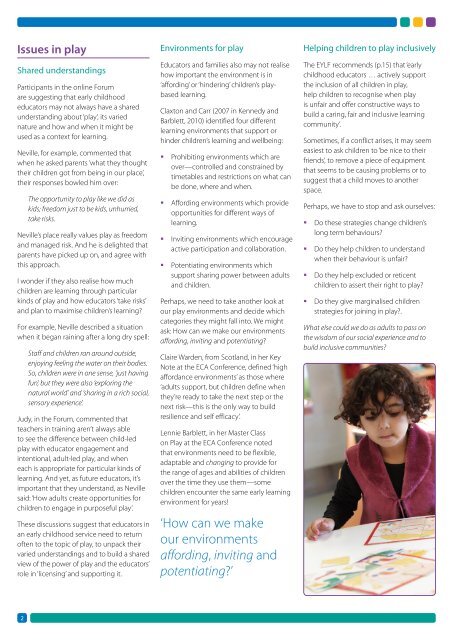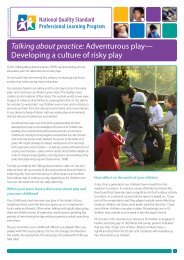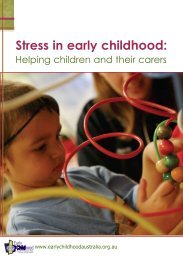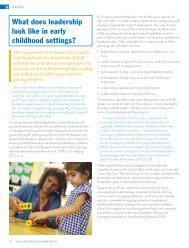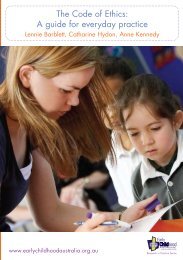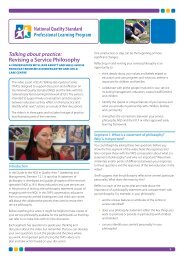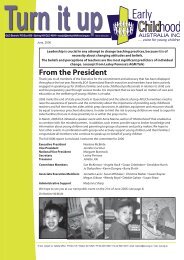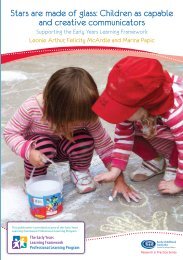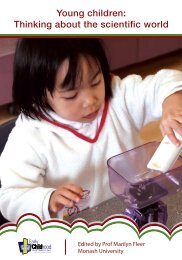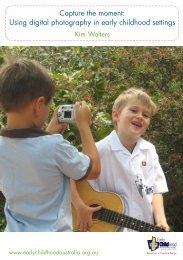Thinking about play - Early Childhood Australia
Thinking about play - Early Childhood Australia
Thinking about play - Early Childhood Australia
Create successful ePaper yourself
Turn your PDF publications into a flip-book with our unique Google optimized e-Paper software.
Issues in <strong>play</strong><br />
Shared understandings<br />
Participants in the online Forum<br />
are suggesting that early childhood<br />
educators may not always have a shared<br />
understanding <strong>about</strong> ‘<strong>play</strong>’, its varied<br />
nature and how and when it might be<br />
used as a context for learning.<br />
Neville, for example, commented that<br />
when he asked parents ‘what they thought<br />
their children got from being in our place’,<br />
their responses bowled him over:<br />
2<br />
The opportunity to <strong>play</strong> like we did as<br />
kids; freedom just to be kids, unhurried,<br />
take risks.<br />
Neville’s place really values <strong>play</strong> as freedom<br />
and managed risk. And he is delighted that<br />
parents have picked up on, and agree with<br />
this approach.<br />
I wonder if they also realise how much<br />
children are learning through particular<br />
kinds of <strong>play</strong> and how educators ‘take risks’<br />
and plan to maximise children’s learning?<br />
For example, Neville described a situation<br />
when it began raining after a long dry spell:<br />
Staff and children ran around outside,<br />
enjoying feeling the water on their bodies.<br />
So, children were in one sense, ‘just having<br />
fun’, but they were also ‘exploring the<br />
natural world’ and ‘sharing in a rich social,<br />
sensory experience’.<br />
Judy, in the Forum, commented that<br />
teachers in training aren’t always able<br />
to see the difference between child-led<br />
<strong>play</strong> with educator engagement and<br />
intentional, adult-led <strong>play</strong>, and when<br />
each is appropriate for particular kinds of<br />
learning. And yet, as future educators, it’s<br />
important that they understand, as Neville<br />
said: ‘How adults create opportunities for<br />
children to engage in purposeful <strong>play</strong>’.<br />
These discussions suggest that educators in<br />
an early childhood service need to return<br />
often to the topic of <strong>play</strong>, to unpack their<br />
varied understandings and to build a shared<br />
view of the power of <strong>play</strong> and the educators’<br />
role in ‘licensing’ and supporting it.<br />
Environments for <strong>play</strong><br />
Educators and families also may not realise<br />
how important the environment is in<br />
‘affording’ or ‘hindering’ children’s <strong>play</strong>based<br />
learning.<br />
Claxton and Carr (2007 in Kennedy and<br />
Barblett, 2010) identified four different<br />
learning environments that support or<br />
hinder children’s learning and wellbeing:<br />
Prohibiting environments which are<br />
over—controlled and constrained by<br />
timetables and restrictions on what can<br />
be done, where and when.<br />
Affording environments which provide<br />
opportunities for different ways of<br />
learning.<br />
Inviting environments which encourage<br />
active participation and collaboration.<br />
Potentiating environments which<br />
support sharing power between adults<br />
and children.<br />
Perhaps, we need to take another look at<br />
our <strong>play</strong> environments and decide which<br />
categories they might fall into. We might<br />
ask: How can we make our environments<br />
affording, inviting and potentiating?<br />
Claire Warden, from Scotland, in her Key<br />
Note at the ECA Conference, defined ‘high<br />
affordance environments’ as those where<br />
‘adults support, but children define when<br />
they’re ready to take the next step or the<br />
next risk—this is the only way to build<br />
resilience and self efficacy’.<br />
Lennie Barblett, in her Master Class<br />
on Play at the ECA Conference noted<br />
that environments need to be flexible,<br />
adaptable and changing to provide for<br />
the range of ages and abilities of children<br />
over the time they use them—some<br />
children encounter the same early learning<br />
environment for years!<br />
‘How can we make<br />
our environments<br />
affording, inviting and<br />
potentiating?’<br />
Helping children to <strong>play</strong> inclusively<br />
The EYLF recommends (p.15) that ‘early<br />
childhood educators … actively support<br />
the inclusion of all children in <strong>play</strong>,<br />
help children to recognise when <strong>play</strong><br />
is unfair and offer constructive ways to<br />
build a caring, fair and inclusive learning<br />
community’.<br />
Sometimes, if a conflict arises, it may seem<br />
easiest to ask children to ‘be nice to their<br />
friends’, to remove a piece of equipment<br />
that seems to be causing problems or to<br />
suggest that a child moves to another<br />
space.<br />
Perhaps, we have to stop and ask ourselves:<br />
Do these strategies change children’s<br />
long term behaviours?<br />
Do they help children to understand<br />
when their behaviour is unfair?<br />
Do they help excluded or reticent<br />
children to assert their right to <strong>play</strong>?<br />
Do they give marginalised children<br />
strategies for joining in <strong>play</strong>?.<br />
What else could we do as adults to pass on<br />
the wisdom of our social experience and to<br />
build inclusive communities?


